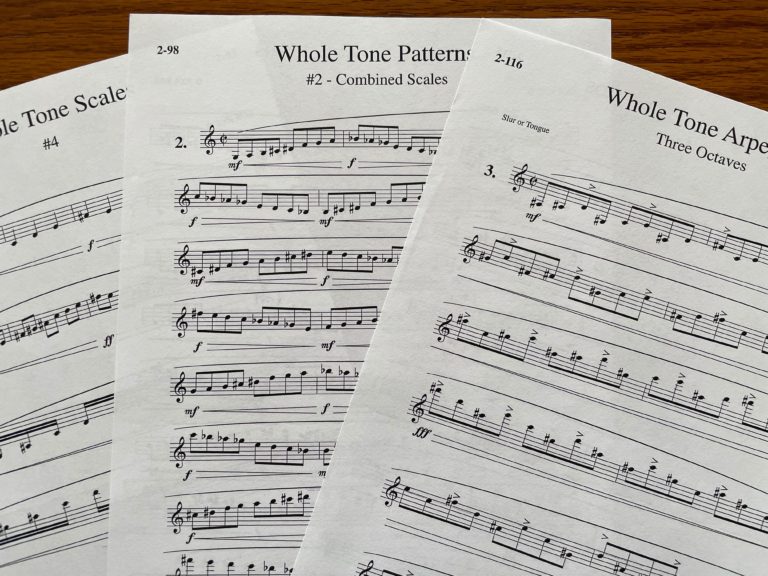

If you have access to a piano or keyboard, practice this scale by playing the pitches slowly for yourself as you sing. The solfege syllables for the descending scale are Do- Ti- Te- La- Le- Sol- Se- Fa- Mi- Me- Re- Ra- Do The solfege syllables for the ascending scale are Do- Di- Re- Ri- Mi- Fa- Fi- Sol- Si- La- Li- Ti- Do Think of the ascending notes as sharps (#) and the descending notes as flats (b). The chromatic solfege scale uses different syllables for the notes going up and coming down. Try playing the scale slowly on the piano and singing along on “Da”. The intervals are small and require a higher level of precision to execute. Practicing this scale is a great fine tuning exercise for your ear. So in the key of C, the chromatic scale looks and sounds like this.
#Chromatic scale trumpet full
To play the chromatic scale for yourself on a piano, simply start on any note and move up in half steps until you have gone up a full octave from your starting pitch. The scale is easy to play on the piano but challenging to sing. I listened and just recorded another great tutorial for you! The chromatic solfege scale is a 12 note scale that covers all of the notes on the piano.
#Chromatic scale trumpet series
The series of twelve notes known as the twelve lü were simply a series of fundamental notes from which scales could be constructed." However, "from the standpoint of tonal music is not an independent scale, but derives from the diatonic scale," making the Western chromatic scale a gamut of fundamental notes from which scales could be constructed as well. However, "it should not be imagined that this gamut ever functioned as a scale, and it is erroneous to refer to the 'Chinese chromatic scale', as some Western writers have done. The ancient Chinese chromatic scale is called Shí-èr-lǜ. Just intonation tuning can be approximated by 19-EDO tuning (P5 = 11 steps = 694.74 cents). The fractions 9⁄ 8 and 10⁄ 9, 6⁄ 5 and 32⁄ 27, 5⁄ 4 and 81⁄ 64, 4⁄ 3 and 27⁄ 20, and many other pairs are interchangeable, as 81⁄ 80 (the syntonic comma) is tempered out. In 5-limit just intonation the chromatic scale, Ptolemy's intense chromatic scale, is as follows, with flats higher than their enharmonic sharps, and new notes between E–F and B–C (cents rounded to one decimal): Main article: Just intonation § Twelve-tone scale

The chromatic scale in Pythagorean tuning can be tempered to the 17-EDO tuning (P5 = 10 steps = 705.88 cents). Where 256⁄ 243 is a diatonic semitone ( Pythagorean limma) and 2187⁄ 2048 is a chromatic semitone ( Pythagorean apotome). 3-limit just intonation) the chromatic scale is tuned as follows, in perfect fifths from G ♭ to A ♯ centered on D (in bold) (G ♭–D ♭–A ♭–E ♭–B ♭–F–C–G– D–A–E–B–F ♯–C ♯–G ♯–D ♯–A ♯), with sharps higher than their enharmonic flats (cents rounded to one decimal): Many other tuning systems, developed in the ensuing centuries, share a similar asymmetry.

Thus, the scale is not perfectly symmetric. Due to a different tuning technique, the twelve semitones in this scale have two slightly different sizes. The most common conception of the chromatic scale before the 13th century was the Pythagorean chromatic scale ( Play ( help Tone rows, orderings used in the twelve-tone technique, are often considered this way due to the increased ease of comparing inverse intervals and forms ( inversional equivalence).
#Chromatic scale trumpet mod
The rising scale is Do, Di, Re, Ri, Mi, Fa, Fi, Sol, Si, La, Li, Ti and the descending is Ti, Te/Ta, La, Le/Lo, Sol, Se, Fa, Mi, Me/Ma, Re, Ra, Do, However, once 0 is given to a note, due to octave equivalence, the chromatic scale may be indicated unambiguously by the numbers 0-11 mod twelve. Similarly, some notes of the chromatic scale have enharmonic equivalents in solfege. It is also notated so that no scale degree is used more than twice in succession (for instance, G ♭ – G ♮ – G ♯). In general, the chromatic scale is usually notated with sharp signs when ascending and flat signs when descending. Its spelling is, however, often dependent upon major or minor key signatures and whether the scale is ascending or descending. The chromatic scale has no set enharmonic spelling that is always used. The circle of fifths drawn within the chromatic circle as a star dodecagram.


 0 kommentar(er)
0 kommentar(er)
